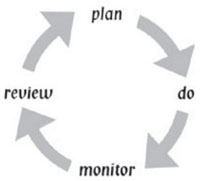Managing Grassy Ecosystems
Adaptive management
Because factors such as climate, soils, distance from other remnants and past management vary from one site to another, the ecological processes associated with each site also vary. This means that there are no set recipes for management. Rather, management needs to be a trial and error process based on the best available information. Adaptive management is an approach that many landholders have intuitively used for decades, but in order to maximise its effectiveness, it is important to monitor and consider the outcomes in an ongoing way, that can perhaps best be described by this diagram.

This process is called 'adaptive management'. In essence, adaptive management treats management actions as experiments. Starting with an 'educated guess' about management regimes (developed from personal experience, published research or communication with others), the management team (often a landholder working with advice from a scientist) records the technique to be used and the expected outcomes (which are preferably defined in measurable terms). The team then implements a particular management activity and compares the result with the expectations. If the activity did not achieve the expectation, the manager then adapts the technique in light of the result and tries again. This approach has been widely used to adapt weed control techniques to local conditions. It is also used intuitively by many landholders, although sometimes they do not have all the information available to them.
The basic steps of adaptive management are:
Plan
- Identify management issues (e.g.weed infestation)
- Identify management goals (e.g.weeds managed, native seedling recruitment)
- Determine management strategies available (e.g. hand removal, targeted herbicide, spot spraying)
- Select appropriate management action (e.g. hand removal)
- Determine what will be monitored and how (e.g. establish a photo point)
- Determine how change and success will be evaluated (e.g. absence of living weeds one month and one year after removal).
Do
- Carry out action (e.g. remove weeds)
Monitor
- Monitor result (e.g. revisit the site and take notes and/or a photo one month and one year after removal)
Review
- Assess management strategy and modify if necessary (e.g. only weed seedlings sprang up, no natives. Try suppressing weed seedlings with plastic. Revegetate by planting natives from locally collected seed)
- Adaptive management guidelines for Box-Gum Grassy Woodlands (2012) (
 179 KB
179 KB
The guidelines include information on:
- Strategic stock grazing
- Domestic stock grazing exclusion
- Expansion and connection of existing remnants
- Slashing
- Weed control
- Re-planting
- Supplementary planting
- Feral and/or native herbivore control/exclusion fencing
- Retention of all dead (and alive) timber
- Retention of rocks
- Exclusion of fire
- Control of feral pigs
- Application of ecological fire management
- Exclude miscellaneous feral species
- Exclude commercial apiary sites
- Maintain natural nutrient levels
| Attachment | Size |
|---|---|
| Adaptive Management Guidelines 2012 | 357 KB |
» Woodlands videos & resources


